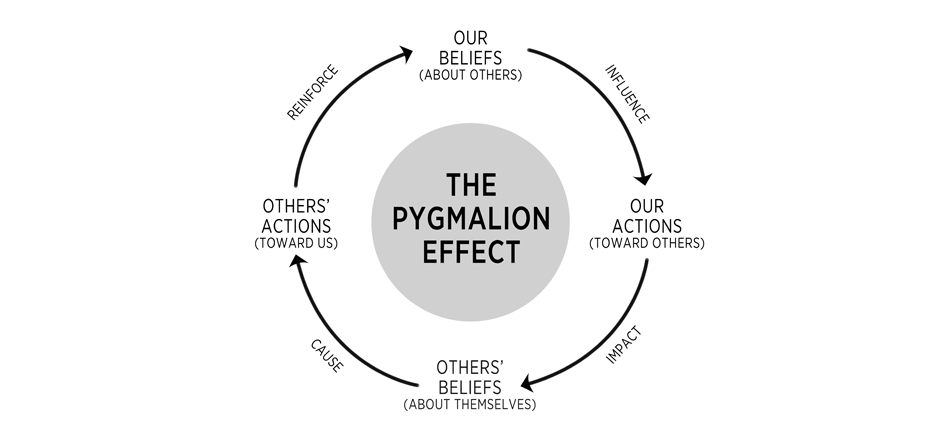Introduction to the Pygmalion Effect
According to Greek mythology, Pygmalion was a prince on the island of Cyprus who created a statue representing his ideal woman, named Galatea. From the moment his creation came to life, Pygmalion fell deeply in love with her and cherished her with all his heart, desiring to be with her. Additionally, Pygmalion demonstrated his sincerity by continuously praying to the goddess of love, Aphrodite, to grant life to Galatea so that they could live together forever. Touched by Pygmalion’s love and talent, the goddess granted his wish and transformed the statue into a living, breathing being. Subsequently, Galatea and Pygmalion embarked on a beautiful love story, got married, and lived happily together for the rest of their lives.

The Pygmalion Effect, also known as the self-fulfilling prophecy, is a psychological phenomenon that describes how the belief and expectations of others can influence an individual’s success or failure. The Pygmalion Effect posits that when others have trust and high expectations of us, we tend to respond to those expectations and achieve higher levels of success. Conversely, when others doubt or have low expectations of us, we may perceive and perform below those expectations. The Pygmalion Effect is driven by the power of perception, as individuals often live up to the expectations set for them.
Processes of the Pygmalion Effect
Link: https://nicvn.com/vi/hieu-ung-pygmalion-bi-quyet-quan-ly-nhan-su
This day and age, the Pygmalion effect can be extensively applied in both personal and work settings. As a manager, if you have strong faith in your team members, their work outcomes can increase by up to 20-30%. This process occurs in a self-contained cycle:

(1) When a manager has strong belief in their employees, it will encourage
(2) The manager’s actions to motivate and support the employees, thereby impacting
(3) The employees’ belief in their own capabilities, leading to
(4) The employees’ dedicated efforts to achieve the expected results. And these expected results further reinforce the manager’s belief that their employees are performing well.
Conversely, if someone starts with a belief that this will not go anywhere and will surely lead to failure, then in their subconscious, all subsequent actions are done only to prove that belief – the belief that I will fail – is correct.
In the field of human resources, the Pygmalion effect plays an important role in shaping performance, developing employees, and organizational success. This article explores the applications and developments of the Pygmalion effect in the field of human resources.
Applications in the Human Resources Field
- Performance Management: The Pygmalion effect can be applied in performance management systems to enhance employee performance. By setting high expectations, providing continuous feedback, and creating a supportive environment, managers can inspire employees to maximize their potential. When employees feel trusted, they tend to perform at their best and exceed expectations.

- Talent Development: The Pygmalion effect can be applied in talent development programs to promote skill development. Identifying employees with high potential and providing them with challenging assignments, training opportunities, and mentoring relationships can boost their confidence and motivation. By believing in their abilities and investing in their development, organizations can nurture future leaders and foster success.

- Leadership Development: The Pygmalion effect is particularly important in leadership development programs. By setting high expectations for emerging leaders, organizations can create a culture of excellence and inspire individuals to take on leadership roles. Leadership training, mentoring, and exposure to challenging projects can help leaders develop and inspire their teams to achieve higher performance.
- Enhancing Employee Commitment: The Pygmalion effect can have a positive impact on employee commitment. When managers trust in the abilities of team members and demonstrate care for their development, employees feel valued and motivated. This belief and support can foster a sense of ownership, commitment, and loyalty among employees, leading to higher levels of engagement and productivity.

- Succession Planning: The Pygmalion effect can be applied in succession planning strategies. Identifying high-potential employees early on and investing in their development can ensure a capable leadership pipeline for the organization’s future needs. By providing targeted training, mentoring, and development opportunities, organizations can groom ready-to-assume successors for key roles and foster continuous success.
Developing the Pygmalion effect in the field of Human Resources
- Training and Education: Organizations can train managers and HR professionals on the principles and significance of the Pygmalion effect. By enhancing awareness and understanding, they can develop the necessary skills to set high expectations, provide constructive feedback, and create a positive work environment that promotes employee development.
- Communication and Feedback: Effective communication is crucial in harnessing the Pygmalion effect. Managers should set clear expectations, provide regular feedback, and acknowledge achievements to reinforce belief and positive behaviors. Open and transparent communication channels allow employees to seek guidance, share progress, and receive support, enhancing their performance.
- Through Recognition and Rewards: Recognizing and rewarding employees’ efforts and accomplishments can amplify the Pygmalion effect. By acknowledging their achievements, organizations reinforce positive beliefs and motivate employees to continue performing at a high level. Well-designed recognition and reward programs can inspire employees, foster a positive work culture, and drive overall engagement and productivity.
- Creating a Development-Oriented Culture: To maximize the Pygmalion effect, organizations should foster a culture that emphasizes employee development. This includes providing opportunities for growth, offering training and mentoring programs, and encouraging continuous learning. When employees feel supported and invested in, they are more likely to strive for excellence and exceed expectations.
- Performance Appraisal and Promotion: The Pygmalion effect can be integrated into performance appraisal and promotion processes. By applying fair and objective evaluation criteria and providing growth-oriented feedback, organizations can empower employees to reach their full potential and make informed decisions regarding promotions and career advancement.
By implementing these strategies, organizations can leverage the Pygmalion effect to enhance employee performance, foster a positive work environment, and drive overall organizational success.





